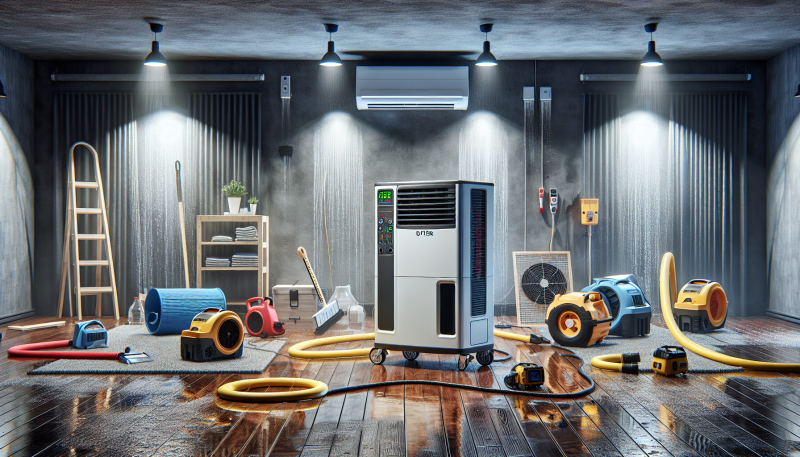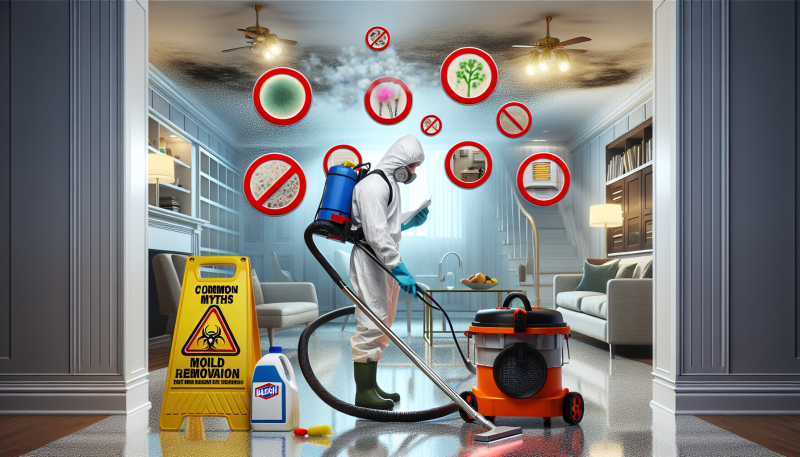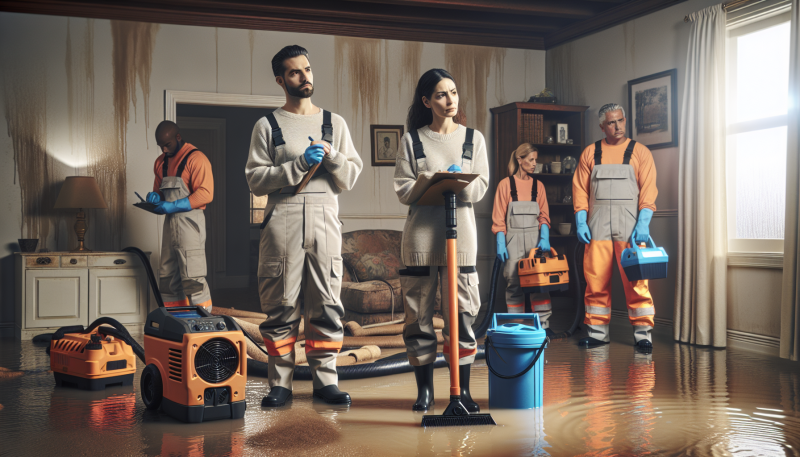Water damage can wreak havoc on your home or business, leading to costly repairs and health risks if not addressed promptly. One of the most effective tools in the recovery process is a dehumidifier. These devices play a crucial role in water damage recovery by removing excess moisture from the air, preventing mold growth, and promoting faster drying of affected areas. At COMMITTED TO QUALITY SERVICE, we understand the importance of acting quickly when water damage occurs. Our fast, friendly, and professional service ensures that your property is restored efficiently and effectively. With specialized equipment designed for drying structures, we are here to help you navigate the challenges of water damage restoration. If you’re facing water damage, don’t hesitate to call us at 855-933-7935 to schedule a consultation and learn more about how dehumidifiers can aid in your recovery process.
Understanding Water Damage: Causes and Consequences
Water damage is a pervasive issue that can arise from various sources, leading to significant consequences for homes and businesses alike. Understanding the causes of water damage is crucial for effective recovery and prevention. Water damage can occur due to natural disasters, plumbing failures, or even human error. Common causes include heavy rainfall, flooding, burst pipes, sewage backups, and appliance malfunctions. Each of these scenarios can introduce large volumes of water into spaces where it can wreak havoc on structures, furnishings, and personal belongings.
The consequences of water damage can be severe and multifaceted. Initially, the most apparent effect is the physical damage to property. Walls, ceilings, and floors can become warped or stained, and structural integrity can be compromised. Beyond the immediate physical damage, water can create an environment conducive to mold growth, which poses health risks to occupants. Mold can develop within 24 to 48 hours after water exposure, leading to respiratory issues and allergic reactions.
Moreover, water damage can result in significant financial implications. The cost of repairs can escalate quickly, especially if the damage is not addressed promptly. According to the Insurance Information Institute, water damage is one of the most common claims made by homeowners, with the average claim costing thousands of dollars. Additionally, the emotional toll of dealing with water damage can be overwhelming, as individuals and families navigate the recovery process and the disruption it causes to their lives.
Preventing water damage is essential, and understanding its causes can help in implementing effective mitigation strategies. Regular maintenance of plumbing systems, proper drainage around the property, and timely repairs of leaks can significantly reduce the risk of water damage. In the event of water intrusion, immediate action is critical. This is where the role of dehumidifiers becomes vital in the recovery process. Dehumidifiers help to remove excess moisture from the air, preventing further damage and inhibiting mold growth.
In summary, water damage is a serious concern that can arise from various sources, leading to significant physical, financial, and emotional consequences. Understanding the causes and consequences of water damage is essential for effective prevention and recovery. For more information on how to protect your property from water damage, visit our about page or explore our services to see how we can assist you.
The Science Behind Humidity and Water Damage
Understanding the science behind humidity and water damage is crucial for effective recovery and restoration processes. Humidity refers to the amount of moisture present in the air, and it plays a significant role in how materials and structures respond to water exposure. When water damage occurs, whether from a burst pipe, flooding, or a leaky roof, the surrounding environment’s humidity levels can exacerbate the situation. High humidity can slow down the drying process, allowing moisture to linger in materials such as wood, drywall, and insulation. This prolonged exposure can lead to structural damage and create an ideal environment for mold growth, which poses health risks and further complicates recovery efforts.
The relationship between humidity and water damage is governed by the principles of evaporation and condensation. When water is introduced into an environment, it begins to evaporate into the air, increasing the humidity levels. If the air is already saturated with moisture, evaporation slows down, making it difficult for affected materials to dry out. Conversely, when humidity levels are low, evaporation occurs more rapidly, facilitating the drying process. This is where dehumidifiers come into play. These devices are designed to remove excess moisture from the air, lowering humidity levels and promoting faster drying of water-damaged areas. By creating an environment conducive to evaporation, dehumidifiers help mitigate the risks associated with prolonged moisture exposure, such as structural damage and mold growth.
In addition to their role in drying, dehumidifiers also help maintain a balanced indoor environment. High humidity can lead to discomfort and health issues, including respiratory problems and allergies. By controlling humidity levels, dehumidifiers contribute to a healthier living space. It is essential to choose the right type of dehumidifier for the specific conditions of the affected area. Factors such as the size of the space, the extent of water damage, and the existing humidity levels all play a role in determining the most effective dehumidification strategy.
The effectiveness of dehumidifiers in water damage recovery is further enhanced when combined with other restoration techniques. For instance, using air movers alongside dehumidifiers can significantly speed up the drying process. Air movers increase air circulation, which helps evaporate moisture from surfaces more quickly. This combination of equipment is often employed by professionals in the field of water damage restoration to ensure thorough drying and minimize the risk of secondary damage.
It is also important to monitor humidity levels during the recovery process. Using hygrometers, restoration professionals can track changes in humidity and adjust their strategies accordingly. This data-driven approach ensures that the drying process is efficient and effective, ultimately leading to better outcomes for homeowners and property managers.
In conclusion, understanding the science behind humidity and its impact on water damage is vital for effective recovery efforts. Dehumidifiers play a crucial role in managing humidity levels, promoting faster drying, and preventing further damage. By utilizing these devices in conjunction with other restoration techniques, property owners can safeguard their homes from the long-term effects of water damage. For more information on water damage recovery and the services available, visit our services or learn more about water damage and its implications.
How Dehumidifiers Work: A Closer Look
Dehumidifiers play a crucial role in the recovery process following water damage, and understanding how they work can help homeowners and property managers make informed decisions during restoration efforts. At their core, dehumidifiers are devices designed to reduce humidity levels in the air, which is essential in preventing further damage and promoting a healthy indoor environment. When water damage occurs, whether from flooding, leaks, or high humidity, moisture can linger in the air and on surfaces, leading to mold growth, structural damage, and other complications.
Dehumidifiers operate on a simple principle: they draw in humid air, remove moisture, and then release drier air back into the environment. The most common type of dehumidifier is the refrigerant model, which uses a cooling coil to condense moisture from the air. When warm, humid air enters the unit, it passes over these coils, which are cooled by a refrigerant. As the air cools, the moisture it contains condenses into water droplets, which are collected in a reservoir or drained away. The now-dry air is then reheated and expelled back into the room, effectively lowering the humidity levels.
Another type of dehumidifier is the desiccant model, which uses materials that naturally absorb moisture from the air. These units are particularly effective in colder environments where refrigerant models may struggle. Desiccant dehumidifiers can be beneficial in specific situations, such as in crawl spaces or basements where temperatures may be lower.
The efficiency of a dehumidifier is measured in pints of moisture removed per day, and the right size unit for a space depends on several factors, including the size of the area, the level of humidity, and the extent of the water damage. For effective water damage recovery, it is essential to choose a dehumidifier that can handle the specific conditions of the affected area.
In addition to reducing humidity, dehumidifiers also help improve air quality by minimizing the risk of mold and mildew growth. Mold thrives in damp environments, and even a small amount of moisture can lead to significant mold issues if not addressed promptly. By maintaining optimal humidity levels, dehumidifiers can help prevent these problems, ensuring a safer and healthier living space.
It is also important to note that dehumidifiers require regular maintenance to operate effectively. This includes emptying the water reservoir if the unit is not connected to a drainage system, cleaning the filters, and ensuring that the coils are free from dust and debris. Proper maintenance not only extends the life of the unit but also ensures that it operates at peak efficiency.
In the context of water damage recovery, dehumidifiers are often used in conjunction with other restoration techniques. For example, air movers may be employed to circulate air and enhance the drying process, while dehumidifiers work to extract moisture from the air. This combination of equipment helps to expedite the drying process, reducing the overall time and cost of restoration.
For those facing water damage, understanding the role of dehumidifiers can be invaluable. They are a key component in the recovery process, helping to mitigate further damage and restore a safe and comfortable environment. If you are dealing with water damage, it is advisable to consult with professionals who can assess the situation and recommend the appropriate equipment and techniques for effective recovery. For more information on our services and how we can assist you in your recovery efforts, visit our services page. Additionally, if you want to learn more about the impact of water damage and how to address it, check out our water damage resources.
Types of Dehumidifiers: Which One is Right for You?
When it comes to recovering from water damage, the right dehumidifier can make all the difference in restoring your home to its original condition. Dehumidifiers are essential tools in the water damage recovery process, as they help to reduce humidity levels, prevent mold growth, and accelerate drying times. However, not all dehumidifiers are created equal, and choosing the right type for your specific situation is crucial. There are several types of dehumidifiers available on the market, each designed for different applications and environments.
The most common types of dehumidifiers include refrigerant dehumidifiers, desiccant dehumidifiers, and whole-house dehumidifiers. Refrigerant dehumidifiers, also known as compressor dehumidifiers, work by cooling the air to condense moisture, which is then collected in a reservoir or drained away. These units are ideal for moderate to high humidity levels and are commonly used in residential settings. They are effective in spaces like basements and bathrooms, where moisture tends to accumulate.
Desiccant dehumidifiers, on the other hand, use a chemical process to absorb moisture from the air. They are particularly effective in low-temperature environments and are often used in industrial applications or areas where refrigerant dehumidifiers may struggle. These units can operate efficiently in colder conditions, making them suitable for places like unheated garages or storage units.
Whole-house dehumidifiers are integrated into your home’s HVAC system and work to control humidity levels throughout the entire house. These systems are ideal for larger homes or areas with persistent humidity issues. They provide a more permanent solution to humidity control and can help improve indoor air quality while protecting your home from the damaging effects of excess moisture.
When selecting a dehumidifier, consider factors such as the size of the area you need to dehumidify, the average humidity levels in your environment, and whether you need a portable unit or a more permanent installation. Additionally, look for features like automatic shut-off, continuous drainage options, and energy efficiency ratings to ensure you choose a unit that meets your needs effectively.
Understanding the different types of dehumidifiers and their specific applications can help you make an informed decision. Whether you are dealing with a minor leak or significant water damage, the right dehumidifier can aid in the recovery process and protect your home from future moisture-related issues. For more information on how to effectively manage water damage in your home, visit our about page or explore our services to see how we can assist you in your recovery efforts.
The Importance of Timely Dehumidification in Recovery
In the aftermath of water damage, whether from flooding, leaks, or other sources, the process of recovery is critical to restoring a safe and healthy environment. One of the most crucial aspects of this recovery process is timely dehumidification. When water infiltrates a structure, it not only saturates surfaces but also creates an environment conducive to mold growth and structural damage. Therefore, addressing moisture levels promptly is essential for effective recovery.
Timely dehumidification plays a vital role in preventing secondary damage that can occur if moisture is allowed to linger. When water is present in the air and on surfaces, it can lead to the growth of mold and mildew, which can start to develop within 24 to 48 hours after water exposure. Mold not only poses health risks to occupants but can also lead to extensive property damage, necessitating costly mold remediation efforts. By employing dehumidifiers as soon as possible, property owners can significantly reduce the risk of mold proliferation and the associated health hazards.
Moreover, dehumidification aids in the drying process of various materials within the affected area. Carpets, drywall, and wooden structures can absorb moisture, leading to warping, weakening, and eventual structural failure if not addressed quickly. Dehumidifiers work by extracting moisture from the air, which accelerates the drying of these materials. This is particularly important in maintaining the integrity of the building and ensuring that it remains safe for occupancy. The faster the drying process, the less likely it is that extensive repairs will be needed, saving both time and money in the long run.
In addition to preventing mold growth and structural damage, timely dehumidification also contributes to the overall comfort and air quality of the environment. High humidity levels can create an uncomfortable living space, leading to issues such as musty odors and increased allergens. By reducing humidity, dehumidifiers help improve indoor air quality, making the space more pleasant for occupants. This is especially important in residential settings where families may be displaced due to water damage and are eager to return to their homes.
Furthermore, the use of dehumidifiers is not just a reactive measure; it is also a proactive strategy in water damage recovery. By incorporating dehumidification into the recovery plan, property owners can ensure that they are taking comprehensive steps to mitigate damage. This proactive approach can be particularly beneficial in commercial settings, where downtime can lead to significant financial losses. By addressing moisture issues swiftly, businesses can minimize disruptions and maintain their operations.
It is also important to note that the effectiveness of dehumidification is enhanced when combined with other recovery techniques. For instance, using air movers alongside dehumidifiers can create airflow that aids in the drying process. This combination ensures that moisture is not only removed from the air but also from surfaces, leading to a more thorough recovery. Professionals in the field of water damage recovery often employ a range of equipment and techniques to achieve optimal results, highlighting the importance of a comprehensive approach.
In conclusion, the significance of timely dehumidification in the recovery process cannot be overstated. It serves as a critical line of defense against mold growth, structural damage, and poor indoor air quality. By acting quickly to reduce humidity levels, property owners can protect their investments, ensure the safety and health of occupants, and facilitate a smoother recovery process. For those facing the challenges of water damage, understanding the role of dehumidifiers and the importance of prompt action can make all the difference in achieving a successful recovery. For more information on our services related to water damage recovery, visit our services page or learn more about our mission at our mission.
Dehumidifiers vs. Natural Drying: Pros and Cons
When dealing with water damage recovery, choosing the right method for drying out affected areas is crucial. Two common approaches are using dehumidifiers and relying on natural drying methods. Each has its own set of advantages and disadvantages that can significantly impact the effectiveness and efficiency of the recovery process.
Dehumidifiers are mechanical devices designed to remove moisture from the air. They work by drawing in humid air, cooling it to condense the moisture, and then releasing drier air back into the environment. One of the primary benefits of using dehumidifiers is their speed and efficiency. In situations where water damage has occurred, such as after a flood or a plumbing leak, time is of the essence. Dehumidifiers can significantly accelerate the drying process, helping to prevent further damage, such as mold growth and structural issues. Additionally, they can be used in conjunction with other drying methods, making them a versatile tool in water damage recovery.
On the other hand, natural drying relies on air circulation and evaporation to remove moisture. This method can be effective in certain situations, particularly in dry and breezy conditions. Natural drying is often less expensive since it does not require the purchase or rental of equipment. However, it can be a slower process, and its effectiveness is highly dependent on environmental conditions. In humid climates or enclosed spaces with limited airflow, natural drying may not adequately remove moisture, leading to prolonged exposure and potential complications like mold growth.
Another consideration is the control of humidity levels. Dehumidifiers allow for precise control over the moisture levels in the air, which can be crucial in preventing damage to materials and belongings. Natural drying, while it can be effective, does not offer the same level of control and can sometimes lead to uneven drying, where some areas dry faster than others, potentially causing warping or cracking in materials.
In terms of energy consumption, dehumidifiers do require electricity to operate, which can lead to increased utility costs. However, the cost of potential damage from mold and structural issues due to inadequate drying can far outweigh the expense of running a dehumidifier. Natural drying, while cost-effective in terms of energy use, may lead to higher costs in the long run if it results in extensive damage that requires professional intervention.
Ultimately, the choice between dehumidifiers and natural drying depends on the specific circumstances of the water damage incident. For immediate and effective recovery, especially in cases of significant water exposure, dehumidifiers are often the preferred choice. They provide a controlled environment that can expedite the drying process and minimize the risk of secondary damage. However, in less severe cases or in favorable weather conditions, natural drying can be a viable option.
For those facing water damage, understanding the pros and cons of these two methods can help in making an informed decision. Whether opting for the efficiency of dehumidifiers or the simplicity of natural drying, it is essential to act quickly to mitigate damage and restore the affected area. For more information on effective water damage recovery strategies, you can visit our about page or explore our services to find the best solutions tailored to your needs.
Setting Up Your Dehumidifier for Maximum Efficiency
To ensure your dehumidifier operates at maximum efficiency during water damage recovery, it is essential to follow specific setup guidelines. First, choose the right location for your dehumidifier. Ideally, it should be placed in the area with the highest humidity levels or where water damage has occurred. This placement allows the unit to effectively draw in moist air and expel drier air, facilitating faster drying of the surrounding environment. Avoid placing the dehumidifier in corners or behind furniture, as this can restrict airflow and reduce its effectiveness.
Next, ensure that the dehumidifier is set to the appropriate humidity level. Most experts recommend maintaining indoor humidity levels between 30 and 50 percent for optimal comfort and to prevent mold growth. If you are dealing with significant water damage, you may want to set the dehumidifier to a lower humidity level to expedite the drying process. Regularly monitor the humidity levels using a hygrometer to adjust the settings as needed.
Another critical factor is ensuring that the dehumidifier has adequate airflow. Keep windows and doors closed to prevent outside humidity from entering the space. Additionally, if your dehumidifier has a continuous drainage option, consider using it. This feature allows for uninterrupted operation without the need to frequently empty the water tank, which can be particularly beneficial during extensive drying efforts.
It is also important to clean or replace the air filter regularly. A clogged filter can impede airflow and reduce the efficiency of the dehumidifier. Most manufacturers recommend checking the filter every few weeks and cleaning or replacing it as necessary. This simple maintenance task can significantly enhance the performance of your unit.
Furthermore, consider the size of your dehumidifier in relation to the space you are trying to dry. A unit that is too small for the area will struggle to remove moisture effectively, while an oversized unit may cycle on and off too frequently, leading to inefficient operation. Refer to the manufacturer’s guidelines to determine the appropriate capacity for your specific needs.
Lastly, be patient. Water damage recovery can take time, and while a dehumidifier is a powerful tool in this process, it is not a miracle solution. Allow the unit to run continuously for several days, checking periodically to ensure it is functioning correctly and making adjustments as necessary. By following these guidelines, you can maximize the efficiency of your dehumidifier and facilitate a more effective recovery process.
For more information on water damage recovery and the services we offer, visit our services page. If you have questions about the process, our FAQ section may provide the answers you need. Understanding the role of dehumidifiers in this context is crucial for effective recovery, so take the time to set up your unit properly.
Common Mistakes to Avoid When Using Dehumidifiers
When utilizing dehumidifiers in the context of water damage recovery, it is essential to understand the common pitfalls that can hinder their effectiveness. Dehumidifiers play a crucial role in restoring moisture balance in affected areas, but improper use can lead to prolonged damage and increased recovery costs. One of the most frequent mistakes is neglecting to assess the specific humidity levels in the environment before deploying a dehumidifier. Without this initial evaluation, you may end up using a unit that is either too powerful or not powerful enough for the space, leading to inefficient moisture removal.
Another common error is failing to maintain the dehumidifier properly. Regular cleaning of the filters and water collection tank is vital to ensure optimal performance. Clogged filters can restrict airflow, while a full tank can cause the unit to shut off, halting the dehumidification process. Additionally, placing the dehumidifier in a poor location can significantly reduce its efficiency. It should be positioned in a central area of the affected space, away from walls and furniture, to allow for proper air circulation.
Many users also overlook the importance of running the dehumidifier continuously during the recovery process. Turning the unit off too soon can lead to residual moisture, which may foster mold growth and further damage. It is advisable to monitor the humidity levels regularly and continue using the dehumidifier until the environment reaches a safe humidity level, typically between 30 and 50 percent.
Another mistake is not considering the size of the dehumidifier in relation to the area being treated. Using a small unit in a large space will result in inadequate moisture removal, while an oversized unit can lead to excessive drying, which may damage materials like wood and drywall. Always refer to the manufacturer’s guidelines regarding coverage area to select the appropriate unit for your needs.
Furthermore, some individuals may underestimate the importance of sealing off the affected area. If the space is not properly contained, outside air can introduce additional moisture, counteracting the dehumidifier’s efforts. It is crucial to close windows and doors and seal any openings to create a controlled environment for effective moisture extraction.
Lastly, many users fail to recognize the need for complementary measures alongside dehumidification. While dehumidifiers are effective, they should be part of a comprehensive water damage recovery strategy that may include professional services for mold remediation and structural repairs. Ignoring these aspects can lead to incomplete recovery and potential health hazards.
By being aware of these common mistakes and taking proactive steps to avoid them, you can significantly enhance the effectiveness of your dehumidifier in the water damage recovery process. Proper usage not only accelerates drying but also helps prevent further complications, ensuring a safer and healthier environment. For more information on effective recovery strategies, visit our services page or explore our about section to learn more about our mission in helping communities recover from water damage.
Monitoring Humidity Levels: Tools and Techniques
Effective monitoring of humidity levels is crucial in the process of water damage recovery, particularly when utilizing dehumidifiers. Understanding the tools and techniques available for monitoring humidity can significantly enhance the efficiency of the recovery process. High humidity levels can lead to further damage, including mold growth and structural issues, making it essential to keep a close eye on moisture levels in the affected area.
One of the most common tools used for monitoring humidity is the hygrometer. Hygrometers come in various types, including analog and digital models, and they measure the relative humidity in the air. Digital hygrometers are often preferred for their accuracy and ease of reading. These devices can provide real-time data, allowing restoration professionals to make informed decisions about when to deploy dehumidifiers and when to adjust their settings. Many modern hygrometers also come equipped with features such as data logging, which can track humidity levels over time, providing valuable insights into the drying process.
In addition to hygrometers, moisture meters are another essential tool in monitoring humidity levels. While hygrometers measure the moisture content in the air, moisture meters assess the moisture content in materials such as wood, drywall, and concrete. This is particularly important in water damage recovery, as it helps determine the extent of moisture penetration into building materials. By using moisture meters, restoration professionals can identify areas that require additional drying and ensure that all affected materials are adequately addressed.
Another technique for monitoring humidity involves the use of thermal imaging cameras. These cameras can detect temperature variations in surfaces, which can indicate the presence of moisture. By identifying cold spots that may suggest water intrusion, restoration teams can target their efforts more effectively. Thermal imaging is a non-invasive method that can save time and resources by allowing professionals to visualize moisture issues without having to damage walls or ceilings.
Data logging systems are also becoming increasingly popular in the field of water damage recovery. These systems can integrate multiple sensors, including hygrometers and moisture meters, to provide a comprehensive overview of the environmental conditions in the affected area. By continuously monitoring humidity levels and material moisture content, restoration teams can create detailed reports that track the progress of the drying process. This data can be invaluable for insurance claims and for ensuring that the recovery process meets industry standards.
In addition to these tools, it is essential to establish a monitoring schedule during the recovery process. Regular checks on humidity levels can help identify any fluctuations that may indicate a problem, such as a malfunctioning dehumidifier or unexpected moisture intrusion. By maintaining a consistent monitoring routine, restoration professionals can respond quickly to any issues that arise, minimizing the risk of further damage.
Proper ventilation is also a critical factor in managing humidity levels during water damage recovery. Opening windows and using fans can help circulate air and reduce humidity, but it is essential to balance this with the need to control indoor moisture levels. In some cases, it may be necessary to seal off areas to prevent outside humidity from entering, especially in humid climates. Restoration professionals must assess the specific conditions of each situation to determine the best approach to ventilation and humidity control.
In conclusion, monitoring humidity levels is a vital aspect of water damage recovery, and utilizing the right tools and techniques can significantly impact the effectiveness of the restoration process. By employing hygrometers, moisture meters, thermal imaging cameras, and data logging systems, restoration teams can gain a comprehensive understanding of the moisture conditions in the affected area. Establishing a regular monitoring schedule and considering ventilation strategies further enhances the ability to manage humidity levels effectively. For those seeking professional assistance in water damage recovery, it is essential to work with experienced teams that understand the importance of precise humidity monitoring. For more information about our services, visit our services or learn more about water damage recovery techniques.
The Role of Dehumidifiers in Preventing Mold Growth
Dehumidifiers play a crucial role in preventing mold growth, especially in the context of water damage recovery. When a property experiences water damage, whether from flooding, leaks, or high humidity, the environment becomes conducive to mold development. Mold thrives in damp conditions, and if moisture levels are not adequately controlled, it can begin to grow within 24 to 48 hours. This rapid growth can lead to significant health risks and structural damage to the property.
The primary function of a dehumidifier is to reduce the humidity levels in the air, making it less favorable for mold spores to settle and proliferate. By extracting excess moisture from the air, dehumidifiers help maintain indoor humidity levels between 30 and 50 percent, which is considered optimal for preventing mold growth. This is particularly important in areas that are prone to moisture accumulation, such as basements, bathrooms, and kitchens.
In addition to controlling humidity, dehumidifiers also assist in the drying process following water damage. When water is present in a home, it can seep into walls, carpets, and furniture, creating a perfect breeding ground for mold. A dehumidifier can expedite the drying process by removing moisture from the air, which in turn helps to dry out these materials more quickly. The faster the drying process occurs, the less likely mold will have the opportunity to establish itself.
Moreover, using a dehumidifier is a proactive measure in mold prevention. Even after water damage has been addressed, residual moisture can linger in the environment. By continuously operating a dehumidifier, homeowners can ensure that humidity levels remain low, thus preventing mold spores from germinating. This is particularly important in climates with high humidity or during seasons when moisture levels tend to rise.
It is also essential to understand that dehumidifiers are not a standalone solution for mold prevention. While they are effective in controlling humidity, they should be part of a comprehensive approach to water damage recovery and mold remediation. This includes addressing the source of the moisture, ensuring proper ventilation, and conducting thorough inspections of the property. For those interested in learning more about effective strategies for dealing with water damage, our services page provides valuable insights.
In summary, dehumidifiers are an essential tool in preventing mold growth during water damage recovery. By effectively reducing humidity levels and facilitating the drying process, they help create an environment that is less conducive to mold proliferation. Homeowners should consider incorporating dehumidifiers into their recovery efforts, along with other preventive measures, to safeguard their properties from the detrimental effects of mold. For more information on mold remediation and prevention, visit our mold remediation page.
Integrating Dehumidifiers into Your Water Damage Recovery Plan
When dealing with water damage, whether from a burst pipe, flooding, or a leaky roof, it is crucial to have a comprehensive recovery plan in place. One of the most effective tools in this recovery process is the dehumidifier. Integrating dehumidifiers into your water damage recovery plan can significantly enhance the effectiveness of the restoration efforts, ensuring that your property is returned to its pre-damage condition as quickly and efficiently as possible.
Dehumidifiers work by removing excess moisture from the air, which is essential in preventing further damage and promoting a healthier environment. When water damage occurs, the humidity levels in the affected area can skyrocket, creating an ideal environment for mold and mildew to thrive. This not only poses health risks but can also lead to additional structural damage to your property. By incorporating dehumidifiers into your recovery plan, you can effectively control the humidity levels, thereby mitigating these risks.
The first step in integrating dehumidifiers into your recovery plan is to assess the extent of the water damage. This assessment will help determine the number and type of dehumidifiers needed. For smaller areas, portable dehumidifiers may suffice, while larger spaces or severely affected areas may require industrial-grade units. It is important to choose the right equipment to ensure optimal drying conditions.
Once you have determined the appropriate dehumidifiers for your situation, the next step is to strategically place them throughout the affected area. Positioning is key; dehumidifiers should be placed in areas where moisture is most concentrated, such as near water-logged carpets, walls, or furniture. Additionally, ensure that the dehumidifiers are not obstructed by furniture or other objects, as this can hinder their effectiveness.
In conjunction with dehumidifiers, it is essential to implement other drying techniques. For instance, using fans to circulate air can enhance the drying process. The combination of air circulation and moisture removal creates a more efficient drying environment. It is also advisable to open windows and doors when possible to facilitate airflow, provided that outdoor humidity levels are lower than indoor levels.
Monitoring the humidity levels during the drying process is crucial. Many modern dehumidifiers come equipped with built-in hygrometers that allow you to track humidity levels in real-time. Keeping an eye on these levels will help you determine when the area has reached an acceptable humidity threshold, typically below 50 percent. Once this level is achieved, you can begin to assess the overall condition of the affected materials and determine if further restoration efforts are needed.
Another critical aspect of integrating dehumidifiers into your recovery plan is the maintenance of the equipment. Regularly checking the water collection tanks and emptying them as needed is essential to ensure that the dehumidifiers continue to operate effectively. Some units may also require filter changes or cleaning to maintain optimal performance.
In addition to their primary function of moisture removal, dehumidifiers can also contribute to the overall comfort of the space during the recovery process. High humidity levels can make an environment feel clammy and uncomfortable, which can be particularly distressing for those already dealing with the stress of water damage. By reducing humidity, dehumidifiers help create a more pleasant atmosphere, allowing occupants to feel more at ease during the recovery period.
It is also important to consider the long-term implications of water damage and the role that dehumidifiers can play in preventing future issues. After the initial recovery process, maintaining appropriate humidity levels in your home or business can help prevent mold growth and other moisture-related problems. This is especially important in areas prone to high humidity or in climates where moisture is prevalent.
For those who are unsure about how to effectively integrate dehumidifiers into their water damage recovery plan, seeking professional assistance can be beneficial. Restoration experts can provide valuable insights and recommendations tailored to your specific situation. They can also assist with the setup and monitoring of dehumidifiers, ensuring that the recovery process is as efficient as possible.
In conclusion, integrating dehumidifiers into your water damage recovery plan is a vital step in ensuring a successful restoration process. By effectively removing excess moisture, dehumidifiers help prevent further damage, promote a healthier environment, and enhance the overall comfort of the space. Whether you are dealing with a minor leak or significant flooding, the strategic use of dehumidifiers can make a substantial difference in the outcome of your recovery efforts. For more information on how to effectively manage water damage and the role of dehumidifiers, consider visiting our about page or explore our services to learn more about our comprehensive restoration solutions. If you are facing water damage challenges, do not hesitate to reach out through our contact page for expert assistance.
Professional vs. DIY Water Damage Recovery: When to Call for Help
When faced with water damage, homeowners often grapple with the decision of whether to tackle the recovery process themselves or to enlist the help of professionals. Understanding the nuances of both approaches can significantly impact the outcome of the recovery effort. Water damage can stem from various sources, including flooding, leaks, or burst pipes, and the extent of the damage can vary widely. This variability is crucial in determining the best course of action.
For minor water damage, such as a small leak or a flooded basement that has not been standing for long, a DIY approach may be feasible. Homeowners can often manage these situations by using dehumidifiers, fans, and other drying equipment to remove moisture from the affected areas. In such cases, it is essential to act quickly to prevent mold growth and further structural damage. A dehumidifier can play a vital role in this process by extracting moisture from the air, thereby speeding up the drying time for walls, floors, and furnishings. Homeowners should also ensure that they thoroughly clean and disinfect any affected areas to prevent health risks associated with mold and bacteria.
However, the decision to go the DIY route should be made with caution. If the water damage is extensive, such as that caused by a significant flood or a major plumbing failure, the risks associated with attempting to recover without professional help can outweigh the benefits. In these situations, the potential for hidden damage is high. Water can seep into walls, under flooring, and into insulation, creating an environment conducive to mold growth and structural issues that may not be immediately visible. Professionals have the training and equipment necessary to detect and address these hidden problems effectively.
Moreover, professionals bring expertise in assessing the damage and determining the best recovery methods. They can identify the source of the water intrusion, which is critical for preventing future incidents. Additionally, they have access to industrial-grade dehumidifiers and drying equipment that can expedite the recovery process far beyond what a homeowner can achieve with standard household tools. This efficiency can save time and money in the long run, as prolonged exposure to moisture can lead to more severe damage and costly repairs.
Another factor to consider is safety. Water damage can pose various health risks, especially if the water is contaminated. Floodwaters can carry harmful bacteria and chemicals, and standing water can create a breeding ground for mold. Professionals are trained to handle these situations safely, using protective gear and following protocols to mitigate health risks. Homeowners may not have the necessary knowledge or equipment to protect themselves adequately during a DIY recovery effort.
In addition to safety concerns, the emotional toll of dealing with water damage can be overwhelming. The stress of managing the recovery process, coupled with the potential for significant financial implications, can lead to hasty decisions. Engaging a professional service can alleviate some of this burden, allowing homeowners to focus on other aspects of recovery and restoration. Professionals can provide a clear plan of action, timelines, and cost estimates, helping homeowners make informed decisions.
Ultimately, the choice between DIY recovery and professional assistance hinges on the severity of the water damage, the potential risks involved, and the homeowner’s comfort level with managing the recovery process. For minor issues, DIY methods can be effective, especially with the aid of dehumidifiers and other drying equipment. However, for more significant damage, the expertise and resources of a professional restoration service are invaluable. Homeowners should carefully assess their situation and consider reaching out to professionals for a consultation, especially if there is any uncertainty about the extent of the damage or the best recovery methods.
In conclusion, while DIY water damage recovery can be a viable option for minor issues, it is crucial to recognize when professional help is necessary. The risks associated with water damage, including hidden structural issues and health hazards, often warrant the expertise of trained professionals. Homeowners should weigh their options carefully and consider the long-term implications of their recovery choices. For those facing significant water damage, contacting a professional restoration service can provide peace of mind and ensure a thorough and effective recovery process. If you are dealing with water damage and need assistance, consider reaching out to a trusted restoration service to discuss your options and receive expert guidance. For more information on our services, visit our services or learn more about water damage recovery.
Cost Considerations: Investing in Dehumidifiers for Recovery
When dealing with water damage recovery, one of the most critical components to consider is the investment in dehumidifiers. These devices play a vital role in restoring a property to its pre-damage condition by effectively removing excess moisture from the air and surfaces. Understanding the cost considerations associated with dehumidifiers can help homeowners and property managers make informed decisions that not only facilitate recovery but also prevent further damage and health risks associated with mold and mildew growth.
The initial cost of purchasing or renting a dehumidifier can vary significantly based on the type, size, and capacity of the unit. For smaller residential units, prices may range from a few hundred dollars to over a thousand, while larger commercial-grade dehumidifiers can cost several thousand dollars. It is essential to assess the scale of the water damage and the size of the area that needs dehumidification to choose the right unit. Investing in a high-capacity dehumidifier may seem costly upfront, but it can save money in the long run by speeding up the drying process and minimizing the risk of secondary damage.
In addition to the purchase or rental cost, operational expenses must also be considered. Dehumidifiers consume electricity, and their energy efficiency can impact overall utility bills. When selecting a dehumidifier, look for energy-efficient models that can effectively reduce moisture levels without significantly increasing energy costs. Some units come with features such as built-in humidistats, which allow for automatic operation based on the humidity level, further optimizing energy use.
Another factor to consider is maintenance and upkeep. Regular maintenance of dehumidifiers is crucial for ensuring their longevity and effectiveness. This includes cleaning filters, checking for clogs, and ensuring that the unit is functioning correctly. While maintenance may incur additional costs, it is a necessary investment to ensure that the dehumidifier operates at peak efficiency, ultimately aiding in the recovery process.
For those who prefer not to purchase or rent dehumidifiers, hiring a professional restoration service can be a viable alternative. Many restoration companies offer comprehensive water damage recovery services, including the use of industrial-grade dehumidifiers. While this option may have a higher upfront cost, it often includes the expertise of trained professionals who can assess the situation, implement the right drying techniques, and ensure that the property is restored safely and effectively. This approach can also save time and effort for property owners who may not have the experience or resources to manage the recovery process themselves.
Additionally, investing in dehumidifiers can have long-term benefits that extend beyond immediate recovery. By effectively controlling humidity levels, these devices can help prevent future issues related to moisture, such as structural damage, mold growth, and health hazards. Mold remediation can be a costly and time-consuming process, so taking proactive measures to maintain a dry environment can ultimately lead to significant savings.
In conclusion, the cost considerations of investing in dehumidifiers for water damage recovery encompass various factors, including initial purchase or rental costs, operational expenses, maintenance, and the potential benefits of hiring professional services. By carefully evaluating these aspects, property owners can make informed decisions that not only facilitate effective recovery but also protect their investments in the long run. For more information on our services related to water damage recovery, visit our services page. If you have further questions, feel free to check our FAQ section for more insights.
Success Stories: How Dehumidifiers Made a Difference in Recovery
In the realm of water damage recovery, dehumidifiers play a pivotal role in restoring properties and ensuring a safe environment for occupants. Numerous success stories highlight how these devices have made a significant difference in recovery efforts, showcasing their effectiveness in mitigating the adverse effects of excess moisture.
One notable case involved a family whose home suffered extensive water damage due to a burst pipe. The initial chaos of the situation left them feeling overwhelmed, but the swift response of a professional restoration team equipped with industrial-grade dehumidifiers transformed their recovery experience. Within hours of the incident, the team set up multiple dehumidifiers throughout the affected areas. These powerful machines worked tirelessly to extract moisture from the air and surfaces, preventing further damage such as mold growth and structural weakening. The family was amazed at how quickly the environment became more comfortable, allowing them to focus on salvaging their belongings rather than worrying about the lingering effects of humidity.
In another instance, a commercial property faced severe water damage after heavy rainfall caused flooding in the basement. The business owner was concerned about the potential loss of inventory and the impact on operations. The restoration team arrived promptly, deploying dehumidifiers to combat the high humidity levels that could lead to mold and mildew. The dehumidifiers not only dried out the space but also improved air quality, making it safe for employees to return. The business owner expressed gratitude for the quick action taken, which minimized downtime and allowed the business to recover swiftly.
Moreover, dehumidifiers have proven invaluable in situations where mold remediation is necessary. A homeowner discovered mold growth in their basement after a prolonged period of high humidity. They contacted a restoration service that utilized dehumidifiers as part of their mold remediation strategy. By reducing the moisture levels in the air, the dehumidifiers created an environment that was less conducive to mold growth. The restoration team was able to effectively remove the mold and prevent its return, ensuring the health and safety of the family. This success story emphasizes the importance of addressing moisture issues promptly to avoid more significant problems down the line.
The effectiveness of dehumidifiers extends beyond immediate recovery efforts. In many cases, they contribute to long-term solutions that protect properties from future water damage. For instance, a property management company implemented a proactive approach by installing dehumidifiers in several of their buildings. This strategy not only helped maintain optimal humidity levels but also reduced the risk of mold and structural damage. Tenants reported improved air quality and comfort, leading to higher satisfaction rates. The management company recognized that investing in dehumidification technology was a wise decision that ultimately saved them money on repairs and maintenance.
In addition to residential and commercial properties, dehumidifiers have also made a difference in historical restoration projects. When a historic building suffered water damage from a leaky roof, preservationists faced the challenge of restoring the structure while maintaining its integrity. They utilized dehumidifiers to carefully control the drying process, ensuring that the materials did not warp or crack. This meticulous approach allowed them to preserve the building’s historical features while effectively addressing the water damage. The successful restoration of the building not only honored its history but also provided a valuable lesson in the importance of moisture control in preservation efforts.
The stories of recovery facilitated by dehumidifiers underscore their essential role in the water damage recovery process. Whether in residential, commercial, or historical contexts, these devices provide a crucial line of defense against the damaging effects of excess moisture. Their ability to improve air quality, prevent mold growth, and expedite drying times makes them indispensable tools for restoration professionals.
For those facing water damage, understanding the importance of dehumidifiers can lead to more effective recovery strategies. It is essential to act quickly and seek professional help to assess the situation and implement the right solutions. Restoration services equipped with the latest technology, including dehumidifiers, can make a significant difference in the outcome of recovery efforts.
In conclusion, the success stories surrounding dehumidifiers in water damage recovery illustrate their transformative impact. From residential homes to commercial properties and historical buildings, these devices have proven their worth time and again. By effectively managing moisture levels, dehumidifiers not only facilitate immediate recovery but also contribute to long-term property protection. For anyone dealing with water damage, investing in professional restoration services that utilize dehumidifiers is a crucial step toward a successful recovery. To learn more about how to protect your property from water damage, visit our services page or explore our water damage resources for valuable insights.
FAQ: The Role of Dehumidifiers in Water Damage Recovery
Q1: What is a dehumidifier and how does it work?
A: A dehumidifier is a device that reduces and maintains the level of humidity in the air. It works by drawing in moist air, cooling it to condense the moisture, and then releasing drier air back into the environment. This process helps to lower humidity levels, which is crucial in preventing mold growth and further damage during water damage recovery.
Q2: Why are dehumidifiers important in water damage recovery?
A: Dehumidifiers play a critical role in water damage recovery by removing excess moisture from the air and surfaces. This helps to dry out affected areas more quickly, reduces the risk of mold and mildew growth, and aids in restoring a safe and healthy environment. Effective moisture control is essential to prevent long-term damage to structures and belongings.
Q3: When should I use a dehumidifier during water damage recovery?
A: Dehumidifiers should be used as soon as possible after water damage occurs. The sooner you start the drying process, the better the chances of minimizing damage and preventing mold growth. It is advisable to run dehumidifiers continuously until humidity levels return to normal and all affected materials are thoroughly dried.
Q4: How do I choose the right dehumidifier for water damage recovery?
A: When selecting a dehumidifier for water damage recovery, consider the size of the affected area, the severity of the water damage, and the capacity of the dehumidifier. Larger spaces or more severe damage may require industrial-grade dehumidifiers, while smaller areas may be adequately served by portable units. Look for features like humidity control settings and continuous drainage options for convenience.
Q5: Can I use a regular home dehumidifier for water damage recovery?
A: While a regular home dehumidifier can be used for minor water damage, it may not be sufficient for larger or more severe situations. Industrial-grade dehumidifiers are designed to handle higher volumes of moisture and are often more effective in quickly drying out affected areas. If the damage is extensive, it may be best to consult with a professional restoration service.
Q6: How long should I run a dehumidifier after water damage?
A: The duration for running a dehumidifier depends on the extent of the water damage and the humidity levels in the area. Generally, you should run the dehumidifier continuously until the affected areas are completely dry and humidity levels stabilize between 30-50%. This process can take several days to weeks, depending on the conditions.
Q7: Are there any safety precautions I should take when using a dehumidifier?
A: Yes, when using a dehumidifier, ensure that it is placed on a stable surface and away from water sources to prevent electrical hazards. Regularly check the water collection tank (if applicable) to avoid overflow. Additionally, ensure proper ventilation in the area to enhance the dehumidification process and maintain air quality.
Q8: Can dehumidifiers help prevent future water damage?
A: While dehumidifiers are primarily used for recovery after water damage, they can also help prevent future issues by maintaining optimal humidity levels in your home. By controlling humidity, you can reduce the risk of mold growth and protect your property from moisture-related problems. Regular use of a dehumidifier in humid climates or during wet seasons can be beneficial.
If you have more questions about the role of dehumidifiers in water damage recovery, feel free to reach out or leave a comment below!










